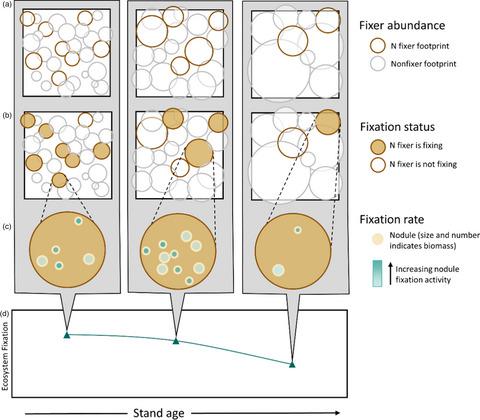Our official English website, www.x-mol.net, welcomes your
feedback! (Note: you will need to create a separate account there.)
A framework for scaling symbiotic nitrogen fixation using the most widespread nitrogen fixer in eastern deciduous forests of the United States
Journal of Ecology ( IF 5.3 ) Pub Date : 2021-11-25 , DOI: 10.1111/1365-2745.13819 Nina Wurzburger 1 , Jessie I. Motes 1 , Chelcy Ford Miniat 2
中文翻译:

在美国东部落叶林中使用最广泛的固氮剂来扩展共生固氮的框架
更新日期:2021-11-25
Journal of Ecology ( IF 5.3 ) Pub Date : 2021-11-25 , DOI: 10.1111/1365-2745.13819 Nina Wurzburger 1 , Jessie I. Motes 1 , Chelcy Ford Miniat 2
Affiliation

|
- Carbon uptake by the terrestrial biosphere depends on supplies of new nitrogen (N) from symbiotic N fixation, but we lack a framework for scaling fixation accurately and for predicting its response to global change.
- We scaled symbiotic N fixation from individual N fixers (i.e. plants that host N-fixing bacteria), by quantifying three key parameters—the abundance of N fixers, whether they are fixing N and their N fixation rates. We apply this framework to black locust, a widespread N-fixing tree in temperate forests of the eastern United States, and harness long-term data from southern Appalachian forests to scale fixation from trees to the landscape and over succession.
- Symbiotic N fixation at the landscape scale peaked in the first decade following forest disturbance, and then declined. This pattern was due to the declining density and declining fixation rates of individual black locust trees over succession. Independent of forest succession, and coincident with chronic atmospheric N deposition, we have evidence suggesting that nodule biomass produced by black locust trees has declined by 83% over the last three decades. This difference in nodule biomass translates to a maximum fixation rate of 11 kg N ha−1 year−1 and a landscape average of 1.5 kg N ha−1 year−1 in contemporary forests.
- Synthesis. We find key controls on symbiotic N fixation by black locust over space and time, suggesting lower fixation rates in eastern deciduous forests than previous estimates. Our scaling framework can be applied to other N fixers to aid predictions of symbiotic N fixation and ecosystem response to global change.
中文翻译:

在美国东部落叶林中使用最广泛的固氮剂来扩展共生固氮的框架
- 陆地生物圈对碳的吸收取决于共生固氮提供的新氮 (N),但我们缺乏准确扩展固氮规模和预测其对全球变化的反应的框架。
- 我们通过量化三个关键参数——N 固定剂的丰度、它们是否固定 N 和它们的 N 固定率,从单个 N 固定器(即,宿主 N 固定细菌的植物)中扩展了共生 N 固定。我们将这个框架应用于刺槐,这是一种在美国东部温带森林中广泛存在的固氮树,并利用来自阿巴拉契亚南部森林的长期数据来衡量从树木到景观和过度演替的固定。
- 景观尺度的共生固氮作用在森林干扰后的第一个十年达到顶峰,然后下降。这种模式是由于单个刺槐树的密度下降和固定率下降。独立于森林演替,并且与长期大气氮沉降相一致,我们有证据表明刺槐树产生的结核生物量在过去三年中下降了 83%。这种结核生物量的差异转化为当代森林中 11 kg N ha -1 year -1的最大固定率和 1.5 kg N ha -1 year -1的景观平均值。
- 合成。我们发现了刺槐在空间和时间上对共生固氮的关键控制,这表明东部落叶林的固氮率低于先前的估计。我们的缩放框架可以应用于其他 N 固定器,以帮助预测共生 N 固定和生态系统对全球变化的响应。











































 京公网安备 11010802027423号
京公网安备 11010802027423号